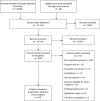Interventions to Reduce Ageism Against Older Adults: A Systematic Review and Meta-Analysis
- PMID: 31219720
- PMCID: PMC6611108
- DOI: 10.2105/AJPH.2019.305123
Interventions to Reduce Ageism Against Older Adults: A Systematic Review and Meta-Analysis
Abstract
Background. Research has found a strong link between ageism, in the form of negative stereotypes, prejudice, and discrimination toward older people, and risks to their physical and mental health. Little is known, however, about the effectiveness of strategies to reduce ageism. Objectives. To assess the relative effects of 3 intervention types designed to reduce ageism among youths and adults-education, intergenerational contact, and combined education and intergenerational contact-by conducting a systematic review and meta-analysis. Search Methods. We searched PubMed, PsycINFO, AgeLine, EBSCO, Embase, Cumulative Index to Nursing and Allied Health Literature (CINAHL), Global Index Medicus, Database of Abstracts of Reviews of Effects (DARE), Epistemonikos, Cochrane Database of Systematic Reviews, Campbell Collaboration, PROSPERO, GreyLit, and OpenGrey. We identified additional records by hand-searching reference lists of relevant review articles as well as records included in the meta-analysis. Two independent reviewers completed the search and screening process. Selection Criteria. Eligible studies were those that (1) evaluated an intervention designed to reduce ageism, (2) examined at least 1 ageism outcome in relation to older adults, (3) used a design with a comparison group (randomized or nonrandomized), and (4) were published after 1970, when the ageism concept was developed. Data Collection and Analysis. Two independent reviewers extracted study-level data from records using a common data collection spreadsheet. They also assessed study quality by using the Cochrane Risk of Bias Tool, and used the Grading of Recommendations, Assessment, Development, and Evaluations (GRADE) tool to assess quality of outcome evidence. Primary outcomes were attitudes toward older people and accuracy of knowledge about aging and older people. Secondary outcomes included comfort with older adults, anxiety about one's own aging, and interest in working in the field of geriatrics or gerontology. We carried out meta-analyses with statistical mixed models. Main Results. We identified 63 eligible studies (1976-2018) with a total sample of 6124 participants. Ageism interventions demonstrated a strongly significant effect on attitudes (differences of standardized mean differences [dD] = 0.33; P < .001), knowledge (dD = 0.42; P < .001), and comfort (dD = 0.50; P < .001), but no significant effect on anxiety (dD = 0.13; P = .33) or working with older adults (dD = -0.09; P = .40). Combined interventions with education and intergenerational contact showed the largest effects on attitudes. We found stronger effects for females and for adolescent and young adult groups. Authors' Conclusions. Interventions are associated with substantial reduction in ageism and should be part of an international strategy to improve perceptions of older people and the aging process. Additional research using more rigorous designs to examine the effects of interventions is strongly recommended. Public Health Implications. Ageism has well-established negative effects on the physical and mental health of older people. Findings suggest that relatively low-cost, feasible strategies involving education and intergenerational contact can serve as the basis of effective interventions to reduce ageism.
Figures



References
-
- North MS, Fiske ST. Modern attitudes toward older adults in the aging world: a cross-cultural meta-analysis. Psychol Bull. 2015;141(5):993–1021. - PubMed
-
- Meisner BA. A meta-analysis of positive and negative age stereotype priming effects on behavior among older adults. J Gerontol B Psychol Sci Soc Sci. 2012;67(1):13–17. - PubMed
Publication types
MeSH terms
Grants and funding
LinkOut - more resources
Full Text Sources
Medical

